Continuing my series of posts of favorite games from the Santa Cruz Cup…
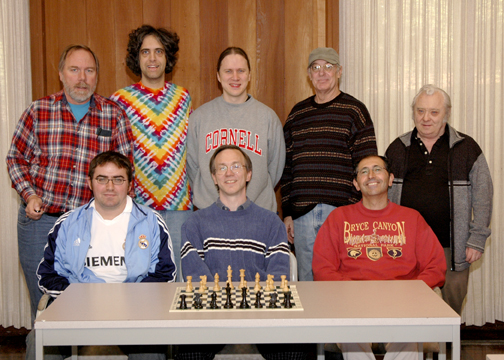
Participants in the 2005 Santa Cruz Cup. Front: Juande Perea, Dana Mackenzie, Ilan Benjamin. Back: Eric Fingal, Ken Seehart, Jeff Mallett, Gary Roe, Jim Parker
The third Santa Cruz Cup, in 2005, was a really weird one for me. I finished first, but only because of unbelievable blunders by my two main rivals, Ilan Benjamin and Juande Perea.
First, a word about the format. After the first year Eric expanded the tournament from 6 to 8 players. This made the double round-robin format unfeasible (a 14-game tournament would have gone on too long), and we had to get creative. I really like the solution we came up with, and I think it should be tried for other invitational tournaments. We split the 8 people into two groups of four and played double round-robins in those groups (6 games). Then the top two in each group went on to a round of 2-game elimination playoffs (semifinals, then finals), while the bottom two in each group went to a round of consolation playoffs. Each player thus played a maximum of 10 games.
Why do I like this format so much? Two words: drama and incentive. The biggest downside of round robins is that people who get off to a bad start have nothing to play for after a while. The longer the round robin, the worse this problem gets. With little incentive to keep playing, you often see dropouts. By contrast, in the quads-followed-by-playoffs format, everybody has an incentive to keep playing. After six games, the slate is wiped clean (sort of). The tail-enders can start over and play for fifth place, a sort of moral victory. The players in third or fourth place now have a realistic chance of finishing first, instead of being hopelessly far behind. And this format guarantees that the winner of the tournament will remain undecided until the very last game. So the final two-game championship match is full of excitement and pressure.
That was certainly the case in 2005, which came down to a match between Ilan Benjamin (the winner in 2003) and me (the winner in 2004). In the first game I drew with Ilan as Black, so it came down to the last game with me as White and Ilan as Black, winner take all.
Now to be honest, this is not a “great game.” It’s more like a tragedy, as Ilan got to a position that was winning in a million different ways, and then had a series of unbelievable mistakes and hallucinations. But it’s also a fascinating psychological study, of what happens when you put a player into a type of position he is not comfortable with, in a situation that is already pressure-packed to begin with.
I’m calling this post “The Perils of Opening Preparation II,” because just like Jeff Mallett in my last post, Ilan had prepared for my opening (which I had played many times in chess club and speed chess) and basically refuted it. I suffered from home-preparation syndrome too. We got to a position that I thought I had studied, and so I played on auto-pilot, making a comical blunder that even a little bit of objective thought would have shown was unplayable. But as I wrote in my last post, after all the craziness of the opening — Ilan’s good preparation and my delusional preparation — you still have to play the game!
Dana Mackenzie – Ilan Benjamin
Santa Cruz Cup 2005
King’s Gambit
1. e4 e5 2. f4 ef 3. Bc4 Nf6 4. e5? …
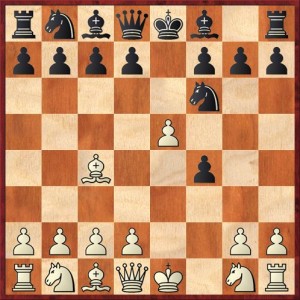 Position after 4. e5. Black to move.
Position after 4. e5. Black to move.
FEN: rnbqkb1r/pppp1ppp/5n2/4P3/2B2p2/8/PPPP2PP/RNBQK1NR b KQkq – 0 4
So here it is, my great innovation. Just like the “Fugly Variation” of the Caro-Kann, which I wrote about last time, White is trying too hard to win too fast. To be honest, I knew this. But one time years ago, when looking at the King’s Gambit, I asked myself why White couldn’t play this move, and I couldn’t figure it out. So I started playing it! Nobody ever found the refutation against me in a tournament game until Ilan.
There are two choices for Black: the positional treatment with 4. … d5 and the greedy treatment with 4. … Ne4. The former move is what most players of Black will play automatically. It’s just something you do in double e-pawn openings: If White plays e5, then … d5 is almost always the thematic response. There is certainly nothing wrong with 4. … d5 here, but after 5. Bb5+ c6 6. ef cb 7. Qe2+ Be6 8. fg Black gets a gloriously wrecked pawn formation, and White has pretty good chances long-term if he can survive the short term.
However, Ilan played the less well-motivated 4. … Ne4, because he knew what I was going to play next: 5. Qf3?! Here almost all Black players will play 5. … Qh4+ 6. Kf1 Ng3+ 7. hg Qxh1, winning the exchange. However, I have a rule: White should always be happy to sacrifice the exchange when playing the King’s Gambit. I’ve had lots of pleasant experiences with this line in speed chess, although it hasn’t come up much in tournaments.
But instead Ilan surprised me with 5. … d5! This is a hard move to see psychologically. After playing Big Daddy Warbucks-style on move 4, Black suddenly grows a conscience and plays positionally.
After this game I spent a despairing weekend going over and over the opening with Fritz, looking for any way at all for White to get a decent position. But the computer was steadfast and its logic was irrefutable. Basically White has two options: bad and worse. White can either win back the gambit pawn and have inferior development in a wide-open position (what happened in our game), or he can let Black keep the pawn and get zero compensation for it.
Not wanting to flog a dead horse, I won’t show you all of the computer analysis, but I should at least mention the line that tactically justifies 5. … d5! White would really like to play 6. d4 — it’s most in the spirit of the King’s Gambit. Unfortunately, White loses a whole piece after 6. d4 Qh4+ 7. Kf1 Ng5! (not 7. … Ng3). (See diagram.)
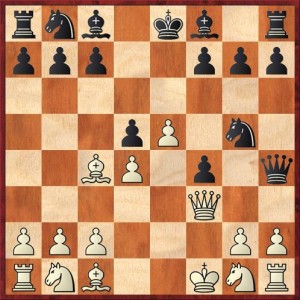 Position after 7. … Ng5! Oops.
Position after 7. … Ng5! Oops.
FEN: rnb1kb1r/ppp2ppp/8/3pP1n1/2BP1p1q/5Q2/PPP3PP/RNB2KNR w kq – 0 8
The gods of chess are punishing White for his presumptuous move 4. e5. There is no way for White to rescue his bishop. If 8. Qxf4 Qxf4 9. Bxf4 Ne6! there are two bishops en prise. If 8. Qxd5 Be6 9. Qb5+ c6 10. Qb3 Ne4! White has no way to both defend mate and hang on to the bishop on c4. As a student of mine from Germany used to say, “Thees socks!”
To be honest I didn’t work this all out OTB — who could? — but I smelled a rat and I just went for recovering the gambit pawn in the simplest way possible: 6. ed Nxd6 7. Qxf4 Nxc4 8. Qxc4. Black has the two bishops, will soon have superior development, and White has an exposed queen and king. It’s a clear, huge advantage for Black. Ilan commented after the game that he hadn’t even studied 7. Qxf4 because it looked so bad for White.
Let’s move ahead a few moves: 8. … Be6 9. Qe2 Nc6 10. Nf3 Bc5. Fritz slightly queried this move for Black and showed 10. … Nd4 as being even better after 11. Nxd4 Qxd4 12. c3 Qh4+. That may be correct, but this to me is crazy computer chess. The simple way for Black to demonstrate his advantage is to continue developing his pieces and certainly not to trade material.
The game continued 11. c3 O-O 12. d4 Re8 13. O-O Bb6 and now a funny thing happened.
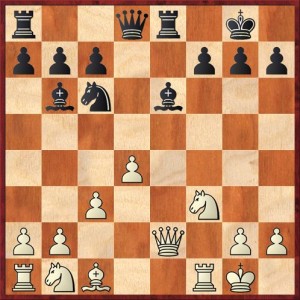 Position after 13. … Bb6. White to move.
Position after 13. … Bb6. White to move.
FEN: r2qr1k1/ppp2ppp/1bn1b3/8/3P4/2P2N2/PP2Q1PP/RNB2RK1 w – – 0 14
I mentioned before that Black’s fifth move surprised me. Nevertheless, somehow around here the position began looking a little bit familiar, like a line I had gone over on the computer. I remembered White’s move as being 14. Qc2? and so I played this move with little thought. 14. Qd3 would have been preferable. Ilan, of course played 14. … Bc4. I was still under the delusion that I had looked at this position before, and so I was wondering, why did the computer think this was okay? Moving the rook with 15. Rf2 just looks wretched. If the computer thinks this position is okay, I reasoned, it must be because of 15. Ng5?? So that’s the move I played!
If ever there was a stupid, delusional thought process, this was it. Because I misremembered this what I had studied on the computer, I followed up my first mistake with a move that is so hideous that I would never have dreamed of playing it ordinarily. It must be okay (NOT!) because the computer said so (NOT!!).
 Position after 15. Ng5. Black to move.
Position after 15. Ng5. Black to move.
FEN: r2qr1k1/ppp2ppp/1bn5/6N1/2bP4/2P5/PPQ3PP/RNB2RK1 b – – 0 15
I can’t imagine what Ilan was thinking. He must have been scratching his head and wondering why I was letting his pieces have complete control over the board so that I could set up beginners’ one-move checking (not even checkmating) threats.
However, here is when we start getting to the psychological part of the game. The weird thing about this game is that all of Black’s forced wins are sacrificial. But Ilan is not a tactician by nature. He is a cautious, strategical player. In this position he plays it completely by the book, amassing positional advantages. The computer keeps screaming, “You can sacrifice and win!” But that’s not the sort of solution that he likes.
So here he plays the sensible, practical 15. … g6. You can’t criticize this move; it’s not a mistake. But a more belligerent type of player would say to White, “I’m not even going to bother defending your threat, because my attack comes first.” And indeed, 15. … Bxd4+! is totally crushing. After 16. cd Qxd4+ 17. Kh1 Bxf1, White’s attack consists of one or two checks, and then it’s over. Or if 17. Qf2 Bxf1, White can’t recapture on f1 because of mate! It’s an utter disaster.
This was a perfect position for a computer. Not for Ilan.
16. Rd1 Re2 17. Qa4 …
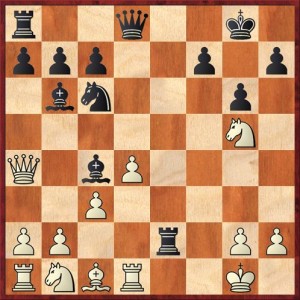 Position after 17. Qa4. Black to play.
Position after 17. Qa4. Black to play.
FEN: r2q2k1/ppp2p1p/1bn3p1/6N1/Q1bP4/2P5/PP2r1PP/RNBR2K1 b – – 0 17
Here we go. Another “Black to play and win” scenario. This game is great training for your tactical vision!
The answer: 17. … Nxd4! Declining the sac is pretty hopeless, e.g. 18. Kh1 Qe7 threatening a back-rank mate. But if 18. cd Black now has a queen sacrifice, 18. … Qxd4+!!, which wins on the spot. After 19. Rxd4 Bxd4+ 20. Kf1 Rae8, mate on e1 or check on f2 followed by mate on f1 is completely unstoppable.
What a gorgeous finish this would have been! Classic stuff, out of the nineteenth century. But Ilan is a 20th century player through and through, and played instead the simple and practical 17. … Qd5. Again, not a blunder. Black is completely in control. Why bother with queen sacrifices when you can play moves like this?
I just played the next few moves in survival mode. There’s not much for White to analyze. The game continued 18. Nf3 Rae8 19. Nbd2 Bb5 20. Qb3 Qf5 21. h3 …
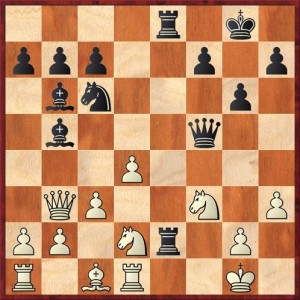 Position after 21. h3. Black to move.
Position after 21. h3. Black to move.
FEN: 4r1k1/ppp2p1p/1bn3p1/1b3q2/3P4/1QP2N1P/PP1Nr1P1/R1BR2K1 b – – 0 21
I have to give Ilan a lot of credit, because up to here he has played impeccably and remained true to his style and to good chess principles. He has resisted all the temptations to sacrifice material until completing his development. Only now, when he has “invited all the pieces to the party,” does he start looking for brilliancies. And he finds one! He plays
21. … Rxg2+!! 22. Kxg2 Re2+ 23. Kg3 …
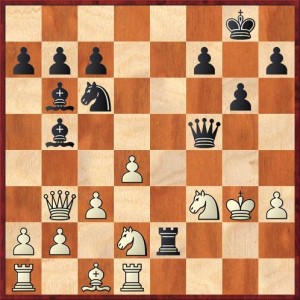 Position after 23. Kg3. Black to move.
Position after 23. Kg3. Black to move.
FEN: 6k1/ppp2p1p/1bn3p1/1b3q2/3P4/1QP2NKP/PP1Nr3/R1BR4 b – – 0 23
There’s just one thing about brilliant sacrifices. If you miscalculate after playing them, you lose.
In this position, some truly weird things started happening. First of all, Ilan just missed my move 23. Kg3. He didn’t even see it. He thought I had to play back to the first rank, and then he would play 23…. Qxh3 and the game would be over. Psychologically, he was shaken, because now he has to justify being a rook down. Nevertheless, he started to play the right move, 23. … Na5!, which wins because of 24. Qb4 Bd7 25. Rh1 c5!
But then Ilan had a flash of inspiration. He suddenly thought, “I can sacrifice my knight on e5!” No matter how White takes, with the pawn or with the knight, he allows a fatal check on f2. And so he played the move that lost the game and the tournament:
23. … Ne5?? 24. Qxb5! …
Wow. In just three moves, Fritz’s evaluation of the position has gone from +6 pawns in favor of Black to +7 pawns in favor of White. As a crestfallen Ilan explained after the game, he had thought I couldn’t take the bishop because of 24. … Qxf3+. He forgot that my knight on d2 was defending f3. Now he eliminates the knight, but it’s too late.
24. Rxd2 25. Rf1 c6 26. Qxe5 Qd7 27. Bxd2 …
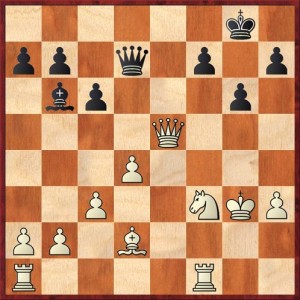 Position after 27. Bxd2. Black to move.
Position after 27. Bxd2. Black to move.
FEN: 6k1/pp1q1p1p/1bp3p1/4Q3/3P4/2P2NKP/PP1B4/R4R2 b – – 0 27
The simplest way. Black can play 27. … Bc7 and win my queen, but a queen can scarcely compete against two rooks and two minor pieces! Instead, Black resigned.
What a strange, strange game. There’s no avoiding the feeling that the wrong player won. But on the other hand, this is the sort of game that I can call on whenever my position looks bleak and hopeless, and I can say, “If I could win that game against Ilan, then there must still be hope for me here.”



{ 3 comments… read them below or add one }
I have demonstrated several games at the Kolty chess club that show that it is perfectly safe to give away a piece, even if you don’t have an immediate win, if the opponent’s king will be permanently exposed. The pawn on d4 is the only defensive bulwark White has, it must be right to sacrifice to get rid of it. On moves 15 and 17 that would be the first thing I would look at.
I’m not sure I agree with your suggestion of 23 … Na5. That move looks illogical to me because it moves an attacking piece away from the king. I would have played 23 … h5 threatening the killing 24 … h4+ 25 Kh4 Qf4#
If 24. h4? Qg4#
If 24. Nc4 h4+ 25. Nh4 Qf2+ 26. Kg4 Qg1+ 27. Kf4 g5+ 28. Kf5 Ne7+ 29. Kf6 Re6#
Hi Mike, I totally agree with you that I would look at the sacs on d4 first. That was what I was looking at during the game and hoping he wouldn’t play them! But it’s an interesting game from a stylistic point of view. Ilan was so cautious and so “correct” in his approach to chess that he just wouldn’t think of playing such a sacrifice before he had it all set up.
Ironically, I’m not sure he would even have played the rook sac on move 21 if he hadn’t thought it led to immediate mate. When it didn’t, because of 23. Kg3, I really think he panicked a bit instead of collecting himself, saying, “Okay, I must still be winning, let me figure out how to do it.”
I agree, your 23. … h5 also works — in fact, now that you mention it, I think that was what I was expecting during the game. 23. … Na5 is not illogical, though. It moves one piece away from the king but frees up two pieces (the two bishops) to move toward the king. With lethal effect, I might add. Still, when you’re in a panicky state of mind this may not be so easy to see. He was probably intending … Na5 just to kick my queen around, and then said, “Oh wait, I can do something much better with my knight!”
Good memories!